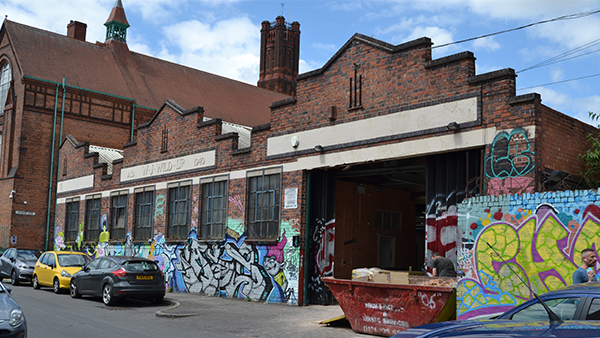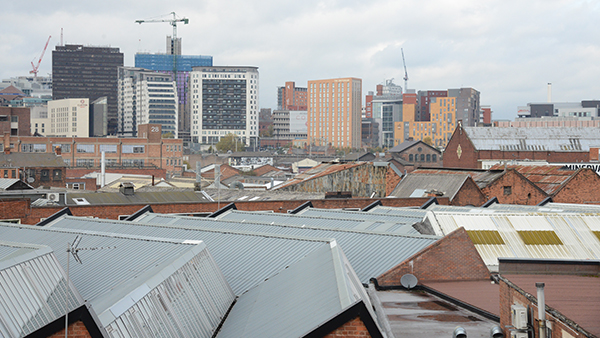News
30 September 2020
Digbeth: The Future is Creative
Building Brum event
What are you looking for?
Much has been planned and discussed in relation to what Digbeth should (or should not) become, even before the promise of HS2 arrival at Curzon Street way back in the noughties, which is now becoming a reality.
Since then, a Birmingham City Council backed policy vision, coupled with developer-led plans and objectives, has culminated in an aspiration to deliver a creative and cultural hub for the West Midlands.
Ahead of the Building Brum event, Digbeth: The Future is Creative, we take a look back at the creativity of Digbeth and the context for a creative and cultural future.
The creation of Birmingham as a settlement owes a lot to the location of Digbeth on the banks of the River Rea. It was here that Birmingham was born, and the city emerged to become an important trading and industrial hub comprising street upon street of factories and warehouses, manufacturing products from Typhoo Tea to Bird’s Custard.
Of course, the macro-scale Industrial Revolution supercharged the socio-economic growth of Digbeth, providing thousands of jobs for local residents and migrants moving from the likes of Ireland. It was the promise of a stable income in pre-modern creative industries, and subsequently the effects of urbanisation, which shaped the cultural identity of Digbeth as the home of industry and the Irish Quarter in Birmingham.

Despite the ill effects of post-industrial decline, the past creativity and cultural make up of Digbeth has always been entwined and lends to its success today as an area for innovation in art, technology, food and film, as exemplified by the success of Yamination Studios, Digbeth Dining Club, and Digbeth Arena, amongst many others.
The precedent set by these businesses and enterprises as start-ups and game-changers in an area defined by post-industrial grit and imperfections is spearheading a revival of Digbeth’s identity on a national footing, and is shaping a transition to a hub of diverse creative and cultural activities.
Digbeth’s uniqueness is valued and is driving forward its regeneration.
The creative industries sector is growing rapidly and contributes to £87bn of GVA, making up 5% of the UK economy and employing more than two million people [1].
The geography of Digbeth ensures it is well placed to significantly contribute to the sustainable and inclusive growth of the sector. A key focus of central Government is to support this growth to attract, develop and retain talent, which in turn requires the revitalisation and creation of new creative workspace, such as that being proposed in and around Digbeth, notably by Oval Real Estate and others.
This geographical opportunity is not missed by the West Midlands Combined Authority (WMCA) who, in its Local Industrial Strategy (May 2019) [2] and ‘Recharge the West Midlands’ (June 2020) [3], shout out loud that Birmingham and the West Midlands have the skills, firms and innovation supply chains and assets to take advantage of global growth in the creative industries sectors.
Though, what makes Digbeth so suited to accommodate this growth is its cluster context. It is home to, and neighbours, key creative content and technology assets, including major innovation, education and business support facilities. This specifically includes the Innovation Birmingham Campus, Birmingham Ormiston Academy, Birmingham Metropolitan College Digital & Creative Career College and Birmingham City University Faculty of Arts, Design & Media and STEAMHouse.

This clustering is recognised by the Greater Birmingham & Solihull Local Enterprise Partnership (GBSLEP) in its Creative Industries Sector Plan (September 2019), which sees Digbeth as an “incubation network and collaborative physical hub” and a quarter for “developing break-through business models” as part of a cultural action zone.
With such support, investment and commitment towards shaping Digbeth as an inclusive creative and cultural hub from the private and public sector, it is not too far from the possibility that Digbeth will again be home to leading producers of technology and digital content. The legacy of the area may even surpass the reputation and achievements of Alfie Bird, inventor of the eponymous custard.
Careful stewardship, intricate place-making leadership and the provision of the right type of space will see this become a reality over the next 10 to 15 years.
To find about more about what makes Digbeth unique and how it is being re-imagined as a pre-eminent independent creative and cultural quarter, register here for the Building Brum webinar on 24 September.
10 September 2020
[1] Independent Review of the Creative Industries
[2] First Local Industrial Strategy to Drive Growth Across the West Midlands
[3] £3.2 billion blueprint unveiled to kickstart the West Midlands’ economic recovery
30 September 2020
Building Brum event